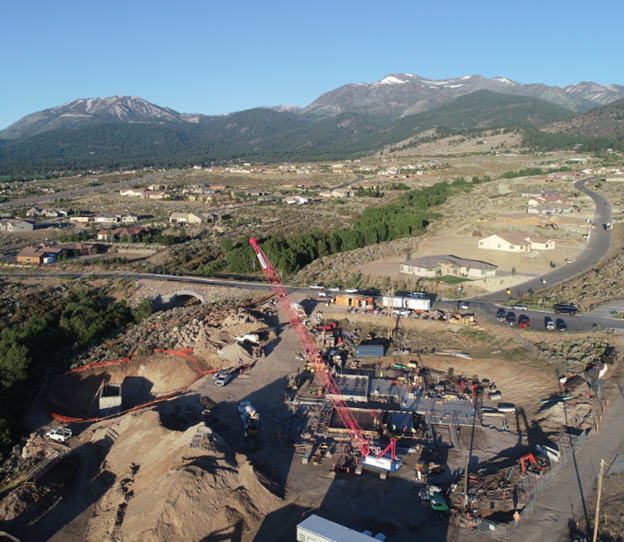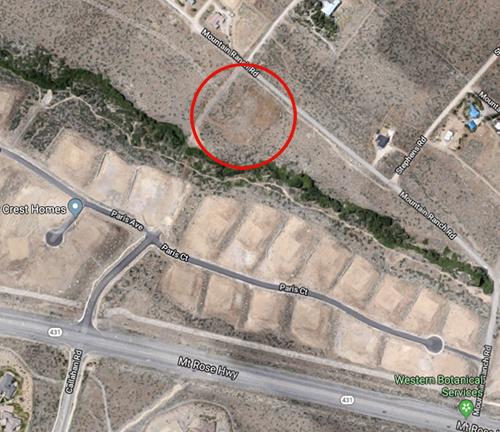The Mt. Rose Water Treatment Plant represents an important infrastructure addition to help TMWA protect groundwater sources on the Mt. Rose Fan. Due to a previous dependence on wells and the resulting decline in area groundwater levels, the Mt. Rose Plant was conceived to provide a supplemental water supply for the area.
When flows are adequate, the plant will treat surface water from Whites Creek. The use of surface water to supplement groundwater is a well-documented water resource management approach known as conjunctive use. The new facility will accomplish this by furthering TMWA’s ability to rest wells and store water in the local aquifer while improving supply reliability.
The plant is located within the Monte Vista subdivision, on the north side of Whites Creek and adjacent to Callahan Road (see satellite image). Using natural colors and similar construction materials to the surrounding homes, the plant’s architecture has been designed to blend with the surrounding neighborhoods. The exterior lighting will be dark skies compliant and the building incorporates stringent specifications to minimize noise.
Why is This Treatment Plant Needed?
- To help improve water resource reliability for our customers and domestic well owners in the area.
- The Mt. Rose and Galena Fan areas have historically relied on groundwater for 100% of their water supply.
- To mitigate declining groundwater levels.
- To accommodate existing and future demands while pumping less groundwater from the aquifer.
How Will the Mt. Rose Water Treatment Plant Help Replenish the Aquifer?
- TMWA will operate the treatment plant and rest and/or recharge specific wells in the area when sufficient creek water is available.
- Only a portion of the flow will be diverted from Whites Creek.
- Based on permits from Nevada Department of Wildlife and the Nevada State Engineer, TMWA will leave enough flow in the creek to maintain wildlife and habitat needs, as well as downstream irrigation requirements.
- There will be reduced or no diversions from the creek to the plant when creek flows are low.
What is being done to minimize impacts to the surrounding neighborhood?
- Minimize large vehicle access to the greatest extent possible.
- Site grading lowers the building elevation.
- Landscaping using large caliper trees and native vegetation will be used to help blend the building into its surroundings.
- Minimal exterior lighting will be used to maintain dark skies.
- Storage tanks, water treatment chemicals and pumps will be housed inside the building; low noise levels will meet design standards.
How the Mt. Rose Water Treatment Plant Fits in to TMWA’s Conjunctive Use Management
In securing more reliable and sustainable water service to the Mt. Rose fan, the following related infrastructure projects have already been completed:
- Three area wells have been retrofitted as part of TMWA’s aquifer storage and recovery program.
- A ten-inch water main and three booster stations have been added to extend TMWA’s Truckee River water supply into the uppermost reaches of the Arrowcreek subdivision, Callahan Ranch and Montreux.
- Finally, a 16-inch water main along Arrowcreek Parkway has been completed (This project, along with a new pump station scheduled for construction in fall of 2019, will tie former customers of the South Truckee Meadows General Improvement District area into TMWA’s distribution system- covering both the Saddlehorn and Thomas Creek Road areas).
TMWA’s efforts combined with recent wet winters has helped raise local groundwater levels 15-20 feet.
Collectively, these projects and the Mt. Rose Water Treatment Plant are designed to maximize surface water supplies from the Truckee River and Whites Creek, when available.

Ariel shot of the Mt. Rose Water Treatment Plant construction site. Taken mid July, 2019.


